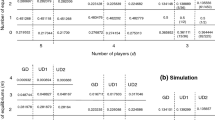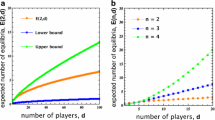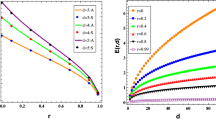Abstract
In this paper, we study the distribution and behaviour of internal equilibria in a d-player n-strategy random evolutionary game where the game payoff matrix is generated from normal distributions. The study of this paper reveals and exploits interesting connections between evolutionary game theory and random polynomial theory. The main contributions of the paper are some qualitative and quantitative results on the expected density, \(f_{n,d}\), and the expected number, E(n, d), of (stable) internal equilibria. Firstly, we show that in multi-player two-strategy games, they behave asymptotically as \(\sqrt{d-1}\) as d is sufficiently large. Secondly, we prove that they are monotone functions of d. We also make a conjecture for games with more than two strategies. Thirdly, we provide numerical simulations for our analytical results and to support the conjecture. As consequences of our analysis, some qualitative and quantitative results on the distribution of zeros of a random Bernstein polynomial are also obtained.







Similar content being viewed by others
References
Abel NH (1824) Mémoire sur les équations algébriques, où l’on démontre l’impossibilité de la résolution de l’équation générale du cinquiéme degré. Abel’s Ouvres 1:28–33
Altenberg L (2010) Proof of the Feldman–Karlin conjecture on the maximum number of equilibria in an evolutionary system. Theor Popul Biol 77(4):263–269
Armentano D, Dedieu J (2009) A note about the average number of real roots of a bernstein polynomial system. J Complex 25(4):339–342
Axelrod R (1984) The evolution of cooperation. Basic Books, New York
Bayin SS (2006) Mathematical methods in science and engineering. Wiley, New York
Bloch A, Pólya G (1932) On the roots of certain algebraic equations. Proc Lond Math Soc S2–33(1):102–104
Broom M, Cannings C, Vickers GT (1993) On the number of local maxima of a constrained quadratic form. Proc R Soc Lond A 443:573–584
Broom M, Cannings C, Vickers GT (1994) Sequential methods for generating patterns of ess’s. J Math Biol 32(6):597–615
Broom M, Cannings C, Vickers GT (1997) Multi-player matrix games. Bull Math Biol 59(5):931–952
Broom M, Rychtar J (2013) Game-theoretical models in biology. CRC Press, Boca Raton
Cannings C, Vickers GT (1988) Patterns of ess’s ii. J Theor Biol 132(4):409–420
Constantinescu E (2005) On the inequality of p. turán for legendre polynomials. J Inequal Pure Appl Math 6(2):28
Curtis LJ (2003) Atomic structure and lifetimes. Cambridge books online. Cambridge University Press, Cambridge
Duong MH, Han TA (2015) On the expected number of equilibria in a multi-player multi-strategy evolutionary game. Dyn Games Appl. doi:10.1007/s13235-015-0148-0
Edelman A, Kostlan E (1995) How many zeros of a random polynomial are real? Bull Am Math Soc (N.S.) 32(1):1–37
Gokhale CS, Traulsen A (2010) Evolutionary games in the multiverse. Proc Natl Acad Sci USA 107(12):5500–5504
Gokhale CS, Traulsen A (2014) Evolutionary multiplayer games. Dyn Games Appl 4(4):468–488
Graham RL, Knuth DE, Patashnik O (1994) Concrete mathematics: a foundation for computer science, 2nd edn. Addison–Wesley Longman Publishing Co., Inc, Boston
Haigh J (1988) The distribution of evolutionarily stable strategies. J Appl Probab 25(2):233–246
Haigh J (1989) How large is the support of an ess? J Appl Probab 26(1):164–170
Han TA, Pereira LM, Lenaerts T (2015) Avoiding or restricting defectors in public goods games? J R Soc Interface 12(103):20141203
Han TA, Traulsen A, Gokhale CS (2012) On equilibrium properties of evolutionary multi-player games with random payoff matrices. Theor Popul Biol 81(4):264–272
Han TA (2013) Intention recognition, commitments and their roles in the evolution of cooperation: from artificial intelligence techniques to evolutionary game theory models, vol 9. Springer SAPERE series
Hardin G (1968) The tragedy of the commons. Science 162:1243–1248
Hart S, Rinott Y, Weiss B (2008) Evolutionarily stable strategies of random games, and the vertices of random polygons. Ann Appl Probab 18(1):259–287
Hauert C, De Monte S, Hofbauer J, Sigmund K (2002) Replicator dynamics for optional public good games. J Theor Biol 218:187–194
Hofbauer J, Sigmund K (1998) Evolutionary games and population dynamics. Cambridge University Press, Cambridge
Karlin S (1980) The number of stable equilibria for the classical one-locus multiallele slection model. J Math Biol 9:189–192
Kontogiannis SC, Spirakis PG (2009) On the support size of stable strategies in random games. Theor Comput Sci 410(8):933–942
Kostlan E (1993) On the distribution of roots of random polynomials. In: From topology to computation: proceedings of the smalefest (Berkeley, CA, 1990). Springer, New York, pp 419–431
Kostlan E (2002) On the expected number of real roots of a system of random polynomial equations. In: Cucker F, Rojas JM (eds) Foundations of computational mathematics (Hong Kong, 2000). World Scientific Publishing, River Edge, NJ, pp 149–188
Kowalski E (2006) Bernstein polynomials and brownian motion. Am Math Mon 113(10):865–886
Legendre M (1785) Recherches sur l’attraction des sphrodes homognes. Mmoires de Mathmatiques et de Physique, prsents l’Acadmie Royale des Sciences, par divers savans, et lus dans ses Assembles, Tome X
Maynard-Smith J (1982) Evolution and the theory of games. Cambridge University Press, Cambridge
Maynard Smith J, Price GR (1973) The logic of animal conflict. Nature 246:15–18
McLennan A (2005) The expected number of nash equilibria of a normal form game. Econometrica 73(1):141–174
McLennan A, Berg J (2005) Asymptotic expected number of nash equilibria of two-player normal form games. Games Econ Behav 51(2):264–295
Nguyen H, Nguyen O, Vu V (2015) On the number of real roots of random polynomials. Commun Contemp Math (to appear)
Nowak MA (2006) Evolutionary dynamics. Harvard University Press, Cambridge
Pacheco JM, Santos FC, Souza MO, Skyrms B (2009) Evolutionary dynamics of collective action in n-person stag hunt dilemmas. Proc R Soc B 276:315–321
Perc M, Szolnoki A (2010) Coevolutionary games–a mini review. Biosystems 99(2):109–125
Petrone S (1999) Random bernstein polynomials. Scand J Stat 26(3):373–393
Santos FC, Santos MD, Pacheco JM (2008) Social diversity promotes the emergence of cooperation in public goods games. Nature 454:213–216
Schuster P, Sigmund K (1983) Replicator dynamics. J Theo Biol 100:533–538
Tao T, Vu V (2014) Local universality of zeroes of random polynomials. Int Math Res Notices 2015(13):5053–5139
Taylor PD, Jonker L (1978) Evolutionary stable strategies and game dynamics. Math Biosci 40:145–156
Turán P (1950) On the zeros of the polynomials of Legendre. Časopis Pěst Mat Fys 75:113–122
Vickers GT, Cannings C (1988) On the number of equilibria in a one-locus, multi allelic system. J Theor Biol 131:273–277
Vickers GT, Cannings C (1988) Patterns of ess’s i. J Theor Biol 132(4):387–408
Zeeman EC (1980) Population dynamics from game theory. Lect Notes Math 819:471–497
Acknowledgments
We would like to thank the anonymous referee for his/her useful suggestions that helped us to improve the presentation of the manuscript.
Author information
Authors and Affiliations
Corresponding author
Appendix
Appendix
Detailed proofs of some lemmas and theorems in the previous sections are presented in this appendix.
1.1 Proof of Lemma 3
This relation has appeared in (Graham et al. 1994, Exercise 101,Chapter 5). For the readers’ convenience, we provide a proof here.
Proof of Lemma 3
Let \(x=\frac{1+q}{1-q}\), from (28) we have
Therefore,
By taking \(q=t^2\), we obtain (31). \(\square \)
1.2 Proof of Theorem 3
Proof of Theorem 3
By taking the derivative of both sides in (31), we obtain
It follows that
Now we compute the expression inside the square-root of the right-hand side of (32). We have
and
Substituting this expression into (33), we get
According to (27), the Legendre polynomial \(P_d\) satisfies the following equation for all \(x\in \mathbf { R}\)
As a consequence, we obtain
Substituting this expression into (48) with \(x=\frac{1+t^2}{1-t^2}\), we get

which is the claimed relation (33). \(\square \)
1.3 Proof of Theorem 4
Proof of Theorem 4
Using the following relation of the Legendre polynomials for all \(x\in \mathbf { R}\)
we get
In particular, taking \(x=\frac{1+t^2}{1-t^2}\), we obtain
Substituting this expression into (33), we achieve
which is (35). \(\square \)
1.4 Proof of Lemma 4
Proof of Lemma 4
This lemma follows directly from Constantinescu 2005 (Theorem 2.1) where the authors proved that
which is negative for all \(|x| \ge 1\). \(\square \)
1.5 Proof of Proposition 2
Proof of Proposition 2
We will prove that
From (35), we have
Therefore \(f_d(t)\) is increasing as a function of d if and only if
We re-write the expression above using the variable x, using the relation \(x^2-1=\frac{4t^2}{(1-t^2)^2}\), as follows
We now simplify this expression using the recursion relation of the Legendre polynomials, i.e. \(dP_{d-1}=(2d+1)xP_d-(d+1)P_{d+1}\). Namely, we have
and
Substituting these calculations into (51) we obtain (38).
To prove the second assertion of Proposition 2, we proceed as follows. Let
Hence, the expression in (38) can be simplified as follows
where \(Q = \frac{(2d+1)P^2_{d}(P^2_{d}-P^2_{d-1})}{(2d-1)P^2_{d-1}(P^2_{d+1}-P^2_{d})} \). Suppose that (39) is true, i.e.,
This implies that \(Q\ge 1\) for all x and d. Then it follows that
By definition of \(H_d\), we have
Substituting this into (52), we obtain
i.e., the condition (38) is satisfied. \(\square \)
Rights and permissions
About this article
Cite this article
Duong, M.H., Han, T.A. Analysis of the expected density of internal equilibria in random evolutionary multi-player multi-strategy games. J. Math. Biol. 73, 1727–1760 (2016). https://doi.org/10.1007/s00285-016-1010-8
Received:
Revised:
Published:
Issue Date:
DOI: https://doi.org/10.1007/s00285-016-1010-8




